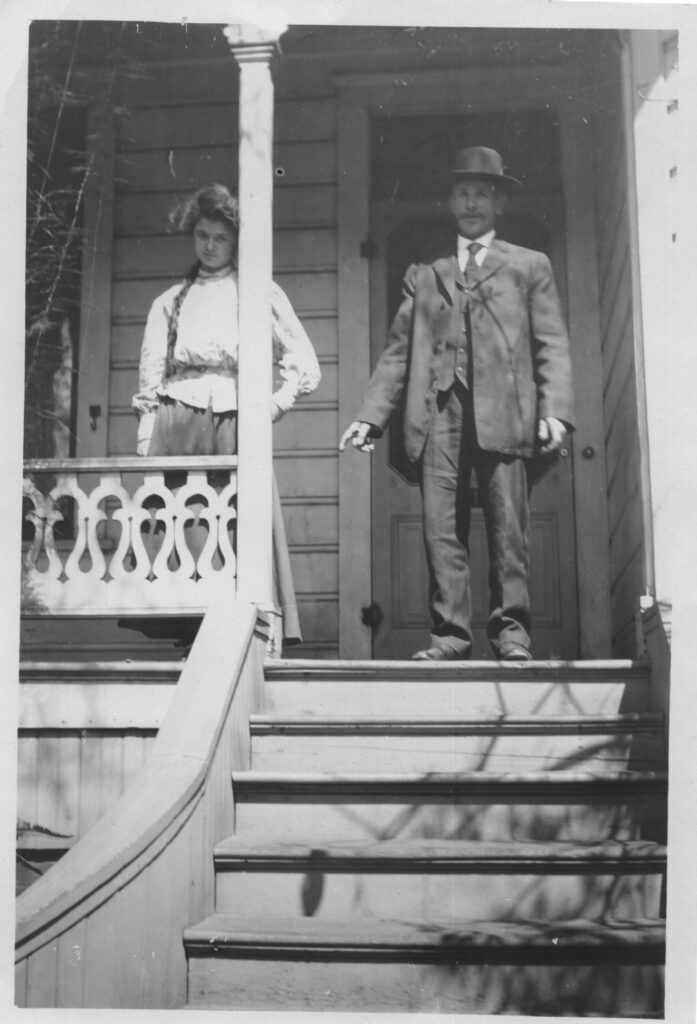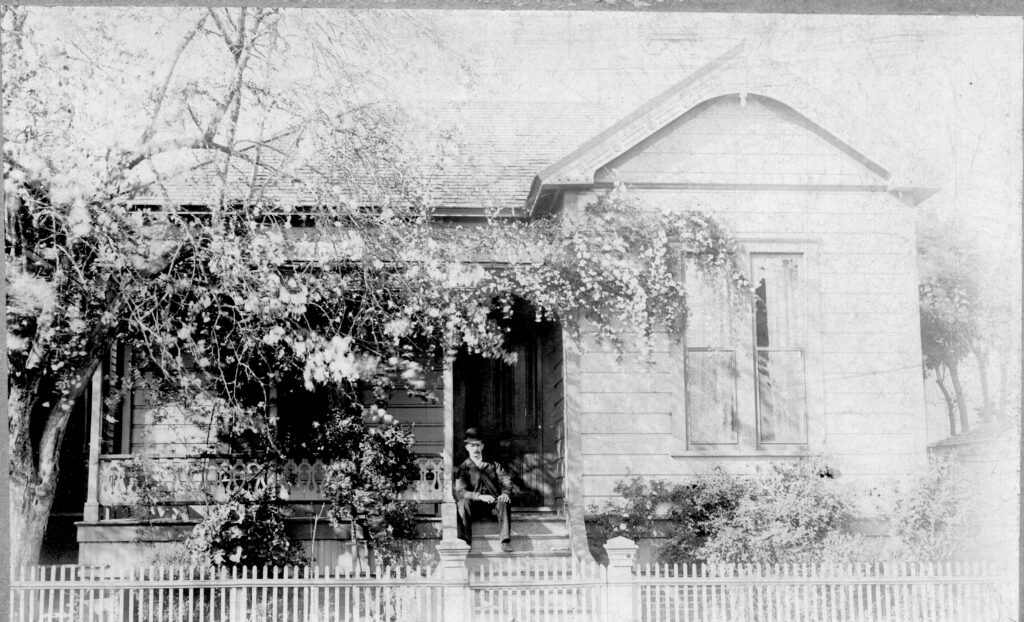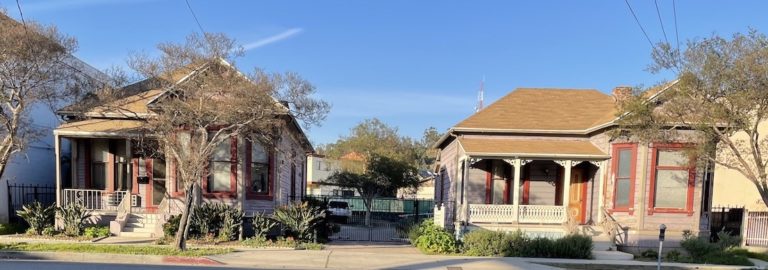The Fritz Family Homes – A Los Angeles Heritage Site
Philip Fritz Sr., a French immigrant, built three houses for his family on Bernard Street beginning in the 1880s. The original Fritz family house was built in 1886, and two additional houses were built on the property in 1888 and 1892. Other properties on Bernard came to be developed and occupied by French immigrants, whose population was growing in Los Angeles. The Fritz family occupied the buildings until 1995 when the Chinese Historical Society of Southern California purchased the property to create its headquarters, the Chinatown Heritage and Visitors Center.

Hailing from Alsace, the Fritz family witnessed great unrest in France. Phillip Fritz Sr. was born in 1844, and he married Louise Schaffner in 1867. Their first son Philip W. Fritz arrived the next year, and the family welcomed the birth of their second son George C. Fritz in 1870. The French Empire declared the War on Germany in 1870. After the Franco-Prussian War, France ceded Alsace and Lorraine to Germany. Two years later, Philip Fritz Sr. and Louise Schaffner Fritz had their third son Fred Fritz.
There is no doubt that political changes had a huge impact on the population. The annexation of Alsace-Lorraine resulted in the emigration of about 300,000 French-speaking residents. Under the push and pull factors of immigration, many Alsace citizens chose to move to France, Britain, and other European countries. The United States was one of the common destinations for Alsace immigrants. In 1872, Philip Fritz Sr.’s brother Gottfried Fritz was the first family member who emigrated to US. Philip Fritz Sr. decided to follow his brother to chase the American Dream. Philip immigrated toAmerica alone in 1873. He became a carpenter in the United States in the hopes of providing comfortable living conditions for his family. Later he worked for the Southern Pacific Railroad in their Buildings and Bridges department, and he eventually rose to the position of superintendent.

The family reunited after almost a decade. Louise Fritz (the elder) and their sons arrived at the port of New York along with Henry Andrew Fritz, Philip’s brother, in 1884. Property ownership was an ideal for immigrant families. Jean (a.k.a. Juan) Bernard, native of French Switzerland, originally owned a brickyard on the land where the Fritz family bought their property, and subdivided it as the Bernard Tract in 1883. The street was named Bernard Street, but was sometimes referred to as Bernardo Street in later vicinity maps. J. H. Whitney of San Fernando purchased Lots 3 and 4 in 1883 and sold them in 1886 to Philip Fritz Sr. who petitioned to have Bernard Street graded from Yale to Buena Vista (now Broadway). He built the first house, 411 Bernard Street, in 1886. Next he built a house at 415 Bernard Street in 1888 and 417 Bernard, in 1892.
In 1890, Phillip Fritz Jr. married Delphine Belaude who is also believed to have originally come from Alsace. They had a daughter named Louise Madeleine Fritz in 1891. Louise’s birthplace is unknown. Family history states that she was born in San Francisco, yet no record of her birth has been found. However, Philip Jr.’s parents picked up baby Louise from San Francisco in fall 1891, and raised her in their house at 411 Bernard Street.

Louise Fritz was raised by her grandparents, and lived at 411 Bernard Street until she married her first husband Clyde Henry Stone in 1917. The Stones moved to 415 Bernard Street, and they had a son Philip Stone who died after 13 days. Louise and Clyde separated in 1924, and Clyde moved out of the house. Louise sued him for divorce, alleging adultery and extreme cruelty. Next in 1927, Louise married Louis Vernon Parker who was a fireman in Orange County. The couple lived at 415 Bernard Street. Apparently the marriage was not stable, and they separated and Louise returned to 411 Bernard Street. When she sued for divorce, she alleged cruelty (due to his habitual intoxication, for which he was discharged from City employment) and obtained interlocutory and final decrees by default in 1935. Eventually, it appears that Louise found the man of her dreams. She married her third husband Otta Ira Whiting, who was a letter carrier, in 1937. Mr. Whiting passed away at the age of 41, of natural causes, in 1950. Louise continued to live at 411 Bernard Street for the rest of her life. She passed away in 1992 at the age of 100.
In 1933, the city of Los Angeles started clearing land for the construction of Union Station, and Old Chinatown was demolished. [note: “The planning and construction of the Metro Rail subway system five decades later included efforts to preserve and protect cultural resources in the area.” resulting in an archaeological collection now archived at the Chinatown Heritage and Visitors Center] New Chinatown and China City opened in Los Angeles after the destruction of Old Chinatown, and Chinese residents began to move into the neighborhoods adjacent to these commercial projects.

In the 1930s, the New Chinatown area witnessed a demographic change. According to the 1940 Federal Census, Chinese American residents started to dwell in the former French community. For instance, the house located on 414 Cottage Home Street was rented by a Mexican family before the 1930s. Loo Lem rented the house and moved in with his wife Leona Lem and their child Warren Lem in between 1931 to 1935. Similarly, the house located on 419 Cottage Home Street was owned by Luis Sealera prior to 1930. Between 1931 and 1935, Joe Loy rented the house and made it a lodging house. He and his eight lodgers were all working for a restaurant as cooks, waiters, and waitresses. Another example of Chinese occupation in the area is the house located on 1315 North Broadway. According to 1940 census, Fon Lee, his mother Lou S. Lee, his wife Lum S. Lee, and their six children moved into the house after 1930.
Louise Whiting spoke about her experiences with the Chinese community. She said that she was aware of a growing Chinese population in her neighborhood and she liked the Chinese living there because she felt secure. In addition, she often went to Chinese restaurants for food. Later, two little Chinese girls in the neighborhood begged Louise to take care of two cats because their lodging house prohibited pets. Louise was very kind and adopted the cats.

The homes located at 411 Bernard Street and 415 Bernard Street are Queen Anne style cottages and are well-preserved examples of late Victorian working class residential design. Moreover, the houses were owned, occupied, or rented out by the Fritz family for over 100 years, and by granddaughter Louise Fritz Whiting for 86 of those years. The houses provide remarkable historical value and architectural continuity.
The Chinese Historical Society of Southern California purchased the Fritz family property in 1994 and created the Chinatown Heritage Center, with a conscious mission to preserve and maintain this unique historical property and keep the memory of the Fritz family alive. It is worth noting that Louise left all of the building and improvement receipts, family pictures, legal documents, and letters when the houses were sold.

